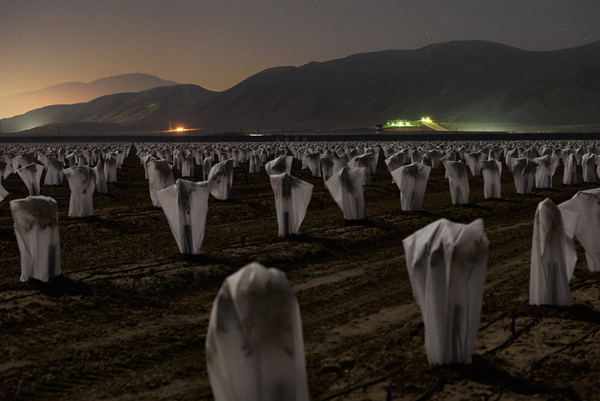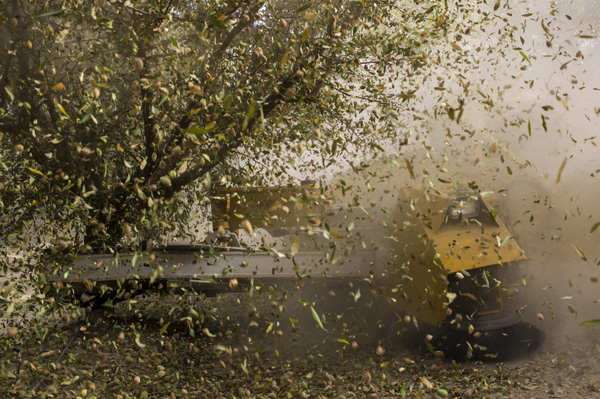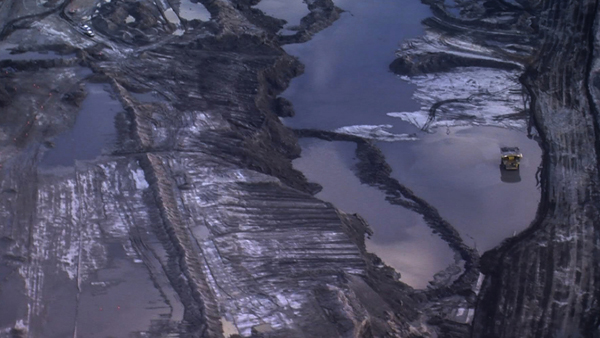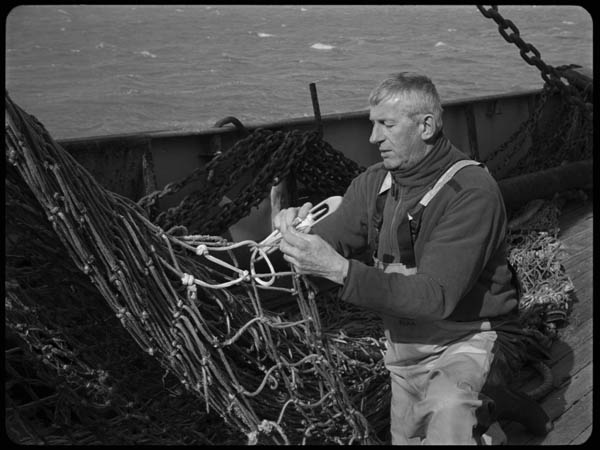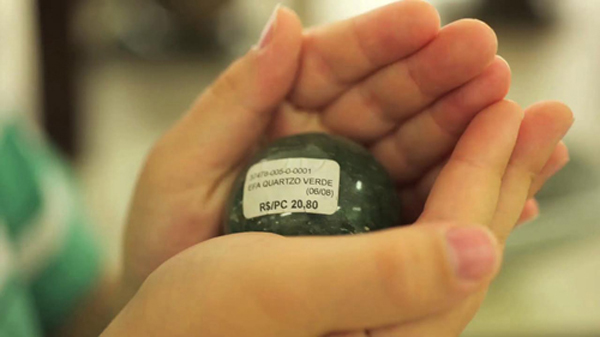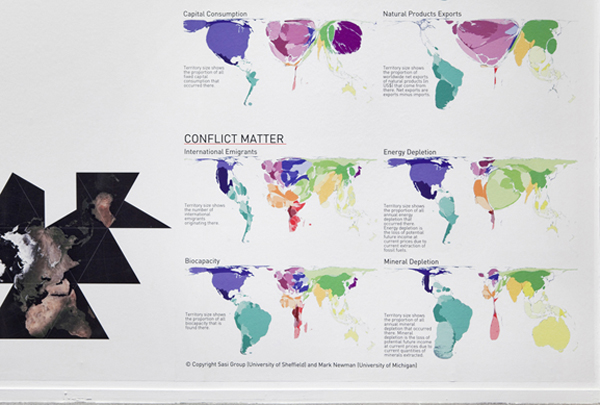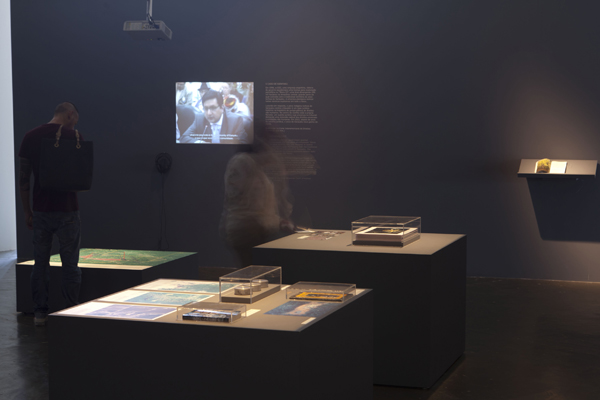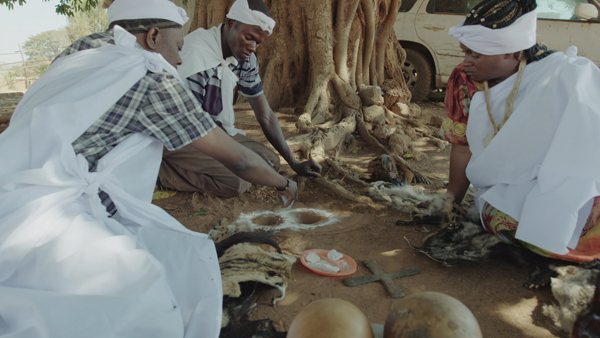World of Matter: Mobilizing Materialities
University of Minnesota, Katherine E. Nash Gallery, September 14th – December 9th, 2017
Works in the Exhibition and films screened on September 14th
Mabe Bethônico, Museum of Public Concerns
The largest museum complex developed in Brazil in recent years involves a series of state-owned buildings that have been transformed into corporate cultural centers in the capital of Minas Gerais, Belo Horizonte. One of them, the Museum of Mines and Metals, was built by a mining group; in another, the history of the state is narrated by the country’s largest multinational mining company. As such, the collective history and cultural production of Brazil are being dictated by the private sector. In these new institutions, relevant questions and debates are ignored, and criticism is all but absent, while the public institutions nearby languish, underfunded. Mabe Bethônico has worked for many years on the issue of mining, especially in Minas Gerais, by studying the cultural and social implications of the state’s mining economy, while also observing the geological and physical affects of its presence. The Museum of Public Concerns is her response to the corporate rewriting of history, which is characterized by disinformation and/or lack of information altogether. The Museum produces a counter-history by spotlighting various, largely-invisible aspects of the mining industry from today and the recent past.
Ursula Biemann, Deep Weather
Oil and water are central to Ursula Biemann’s ongoing research. Deep Weather (2013) is a nine-minute glimpse of the Alberta tar sands, juxtaposed with the watery world of Bangladesh. The whispered, confiding voice-over makes us feel immediately complicit in the actions unfolding here. While human actions are paramount in what happens to the Earth in this Anthropocene era, we have little awareness of, or control over, fluid and invisible global interactions. The vast open-pit mines and steam processing of the oil-infused sand and clay of northern Alberta have drastically lowered Athabasca River flow to the Arctic Ocean; poisoned tailing ponds are replacing the boreal forests, altering ecology for an unknown future. Land is reduced to a commodity by multinational corporations with little concern for the planet’s future well-being. In Bangladesh, rising sea levels – a result of melting Himalayan ice – are claiming inhabitable land, impacting large populations with nowhere else to go. Communities respond by sandbagging mud embankments and devising floating agriculture and convertible schools: manual efforts on a heroic scale against nearly impossible odds. The two sections of Deep Weather reveal underlying links between these widely separated locations, asking that we know our place within planetary ecology, and think of the future we build through our actions today.
Ursula Biemann and Paulo Tavares, Forest Law
Forest Law is a collaborative video project on the cosmopolitics of Amazonia. It draws on research carried out in the oil-and-mining frontier in the Ecuadorian Amazon— one of the most biodiverse and mineral-rich regions on Earth, currently under pressure from the massive expansion of extraction activities. At the heart of Forest Law is a series of landmark legal cases that bring the forest to court and plead for the rights of nature. A particularly paradigmatic trial has recently been won by the indigenous people of Sarayuku based on their cosmology of the Living Forest/ La selva viviente. Forest Law is a synchronized video projection shot with two cameras and a photo-text assemblage unfolding the background to these cases. Taken together, the collection of personal testimonies and factual evidence expose the multiple dimensions of the tropical forest as a physical, legal, and cosmological entity.
Lonnie van Brummelen and Siebren de Haan, Episode of the Sea
The film, Episode of the Sea, is the outcome of a two-year collaboration by the artists Lonnie van Brummelen and Siebren de Haan with the fishing community of Urk, a former island in the Netherlands. In the previous century, the Dutch closed off and drained their inland sea to reclaim new arable land. The island of Urk, situated in mid-sea, suddenly found itself embraced by land. Its inhabitants were expected to switch from fishing to farming, but the fishermen found new fishing grounds, far out in the North Sea thereby managing to continue their trade. Despite being part of the mainland for decades, the fishing village is still notoriously insular and its inhabitants continue to speak their own language. With a residency and numerous visits to Urk, the artists gradually gained the Urkers’ trust. They documented the actions and sites of fishing and filmed a dozen staged scenes, performed by members of the fishing community themselves in their local dialect. Meanwhile, the artists kept a log of their encounters and experiences in situ. Episode of the Sea brings these diverse materials together, documenting the material world of a contemporary North Sea fishery and the fishermen’s struggle with a changed public perception, fluctuating regulations, and excessive global competition, while drawing parallels between fishing and filming. Rendered in black-and-white the scenes evoke neo-realist cinema and early documentary genres and recall a way of life that has been passed along by ancestors, yet is on the verge of obsolescence.
Frauke Huber and Uwe H. Martin, LandRush – Dry West
LandRush is an artistic exploration of the social and environmental impact of large-scale agro-investments on rural economies and land rights, the boom of renewable fuels, the reallocation of land, and the future of agriculture around the world. LandRush’s newest chapter Dry West documents the hydrological society of the American West, where rivers run in concrete beds, across mountains and deserts and up towards money. But even where the eye sees a wild river or natural lake, chances are that nature is nothing more than an illusion in the artificial landscapes of the Anthropocene.
Peter Mörtenböck and Helge Mooshammer, Frontier Climates
From Canada’s tar sands rush to the deep rainforests of the Amazon basin and from Chinese boomtown urbanism to seabed mining in the Arctic, many critical sites of resource exploitation are governed by frontier climates. It is the combination of peripheral characteristics – geographical remoteness, demographic marginalization, ideological oblivion – which enables things to emerge that would not be present otherwise. Indeed, the frontier is characterized by its expansionary practices as a site of interaction and confrontation. It is not a given space, but rather created through a series of advances aiming to structure a field of options. In other words, the frontier is shaped by the ongoing presence of what can be understood as a frontier mentality. In Frontier Climates, Peter Mörtenböck & Helge Mooshammer trace the forces and ideologies as well as the materialities and representations that allow for this mentality to crystallize into action. Through a collection of sites that engender distinct frontier operations, Mörtenböck & Mooshammer address the making of politico-material frontier climates as an active force in neoliberal globalization.
Xavier Ribas, Desert Trails
Since 2009, Xavier Ribas has devoted his photographic practice to looking into the natural history of Chilean nitrate in response to the 19th century photographic album Oficina Alianza and Port of Iquique 1900 held in the collection of the Museo Universidad de Navarra (MUA), in Pamplona, Spain. The result of this investigation is Nitrate, a large body of work researched and photographed in Chile, Great Britain, Spain and the United States. Nitrate explores the legacies of Chilean sodium nitrate, a nonrenewable natural resource extensively mined in Northern Chile between 1870’s and 1920’s by foreign capitalists, mostly British, who in relatively few years transformed a portion of the Atacama desert into an industrial landscape. Desert Trails (2012) is a grid of 33 photographs of the Atacama Desert taken mostly from the vantage points of slag heaps of former nitrate works. The photographs show the disrupted surfaces of the desert around abandoned industrial sites, towns and ore fields. Formally, this images emulate the panoramic views of historical photographs from the time of the nitrate works, produced for or by the nitrate producers themselves as record of investment or for propaganda purposes, and collected in photographic albums now held in national libraries, archives and museums.
Bodil Furu, Copper Eaters
Copper Eaters (2016, 80 min.), a film by Bodil Furu, where the extraction of copper and obliteration of the natural landscape in a rural area of the Democratic Republic of the Congo is framed from different perspectives: fictional mythologies, business-oriented discourse, the consequences of Belgian colonialism, traditional methods, the impact of industrial mining, the contemporary life of villagers, their strategies of negotiation—complexity, instead of simplification, ensues.
Steve Rowell, Midstream and Twilight
Midstream and Twilight (2016, 20 min.), is a moving image work by Steve Rowell. Through the aerial perspective of a drone, the film traces the liminal infrastructure of oil pipelines between its source in the tar sands of Canada’s boreal forest to a landscape of refineries in the US Midwest. When viewed, Midstream at Twilight functions as a form of contextual direct action and as such, invokes a corporate death curse against a fossil fuel industry in decline. What began in the 17th century must end in the 21st. Made possible by a combined grant from the Museum of Contemporary Photography, Chicago and the Natural Resources Defense Council.

